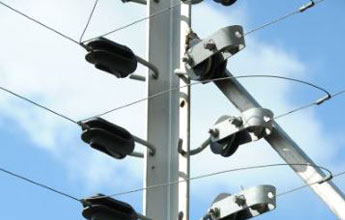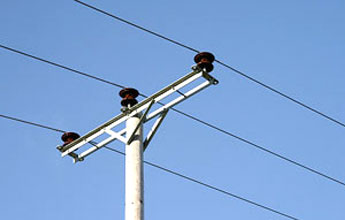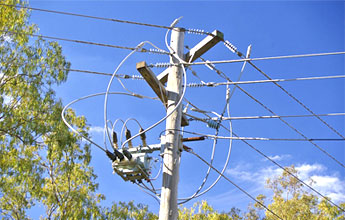Insulators can be divided into suspension insulators and pillar insulators according to different installation methods; according to the different insulating materials used, they can be divided into porcelain insulators, glass insulators and composite insulators (also called synthetic insulators); according to different voltage levels used, they can be divided into They are low-voltage insulators and high-voltage insulators; according to the different environmental conditions of use, pollution-resistant insulators for use in polluted areas are derived; according to different types of voltage used, DC insulators are derived; there are also various special-purpose insulators, such as insulating cross arms, Semiconductor glazed insulators and tension insulators for power distribution, bobbin insulators and wiring insulators, etc. In addition, according to the different breakdown possibilities of insulating parts, they can be divided into two types: type A, which is a non-breakdown insulator, and type B, which is breakdown-type insulator.
Suspension insulators are widely used in the insulation and mechanical fixation of high-voltage overhead transmission lines and soft busbars in power generation and substations. Suspension insulators can be divided into disc-shaped suspension insulators and rod-shaped suspension insulators. Disc suspension insulator is a type of insulator widely used in transmission lines. Rod-shaped suspension insulators have been widely used in Germany and other countries.



Pillar insulators are mainly used for the insulation and mechanical fixation of busbars and electrical equipment in power plants and substations. In addition, post insulators are often used as components of electrical equipment such as isolating switches and circuit breakers. Among pillar insulators, they can be divided into pin pillar insulators and rod pillar insulators. Pin-type pillar insulators are mostly used in low-voltage distribution lines and communication lines, while rod-type pillar insulators are mostly used in high-voltage substations.
Porcelain insulator is an insulator made of electrical ceramics. Electrical ceramics are baked from quartz, feldspar and clay. The surface of porcelain parts of porcelain insulators is usually covered with enamel to improve its mechanical strength, waterproof infiltration and increase surface smoothness. Among various types of insulators, porcelain insulators are most commonly used.
Glass insulator is an insulator made of tempered glass. Its surface is in a state of compressive prestress. If cracks and electrical breakdown occur, the glass insulator will break into small pieces on its own, which is commonly known as "self-explosion". This feature eliminates the need for "zero value" detection of glass insulators during operation.
Composite insulators are also called synthetic insulators. The insulator is composed of a fiberglass resin core rod (or core tube) and an organic material sheath and shed. It is characterized by small size, light weight, high tensile strength and excellent anti-pollution flashover performance. But its anti-aging ability is not as good as that of porcelain and glass insulators. Composite insulators include: rod-shaped suspension insulators, insulating cross arms, pillar insulators and hollow insulators (ie composite bushings). Composite bushings can replace porcelain bushings used in a variety of power equipment, such as transformers, lightning arresters, circuit breakers, capacitive bushings and cable terminals. Compared with porcelain sleeves, it not only has the advantages of high mechanical strength, light weight and small dimensional tolerance, but also can avoid damage caused by explosion.
Low-voltage insulators and high-voltage insulators Low-voltage insulators refer to insulators used for low-voltage distribution lines and communication lines. High-voltage insulators refer to insulators used in high-voltage and ultra-high-voltage overhead transmission lines and substations. In order to meet the needs of different voltage levels, different numbers of single insulators (pieces) of the same type are usually used to form insulator strings or multi-section insulating pillars.
Pollution-resistant insulators mainly take measures to increase or enlarge the insulator shed or ribs to increase the creepage distance of the insulator and improve the electrical strength of the insulator in a dirty state. At the same time, the structural shape of the shed is also changed to reduce the amount of natural dirt accumulation on the surface to improve the anti-pollution flashover performance of the insulator. The specific creepage distance of pollution-resistant insulators is generally 20% to 30% higher than that of ordinary insulators, or even more. Areas with frequent pollution flashovers in China's power grid are accustomed to using pollution-resistant insulators with a double-layer umbrella structure. Such insulators have strong self-cleaning capabilities and are easy to clean manually.
DC insulators mainly refer to disc insulators used in DC transmission. DC insulators generally have a longer creepage distance than AC pollution-resistant insulators, and their insulating parts have higher volume resistivity (not less than 10Ω·m at 50°C). Their connecting fittings should be equipped with sacrificial materials to prevent electrolytic corrosion. Electrodes (such as zinc sleeves, zinc rings).
Type A insulator and type B insulator. Type A is a non-breakdown insulator. Its dry flashover distance is not more than 3 times (casting resin) or 2 times (other materials) of the dry breakdown distance: Type B can break down. type insulator, its breakdown distance is less than 1/3 (casting resin) or 1/2 (other materials) of the dry flashover distance. The dry flashover distance of an insulator refers to the short distance through the air along the outer surface of the insulator; the breakdown distance refers to the short distance through the insulating material of the insulator.


